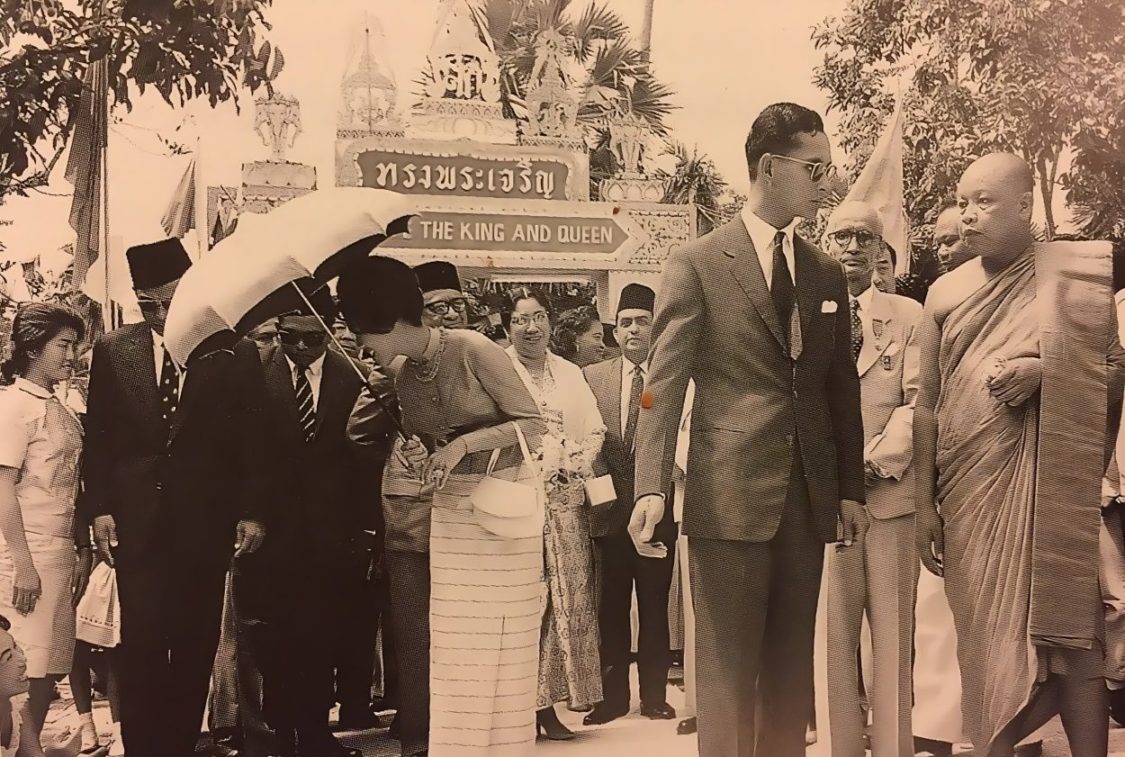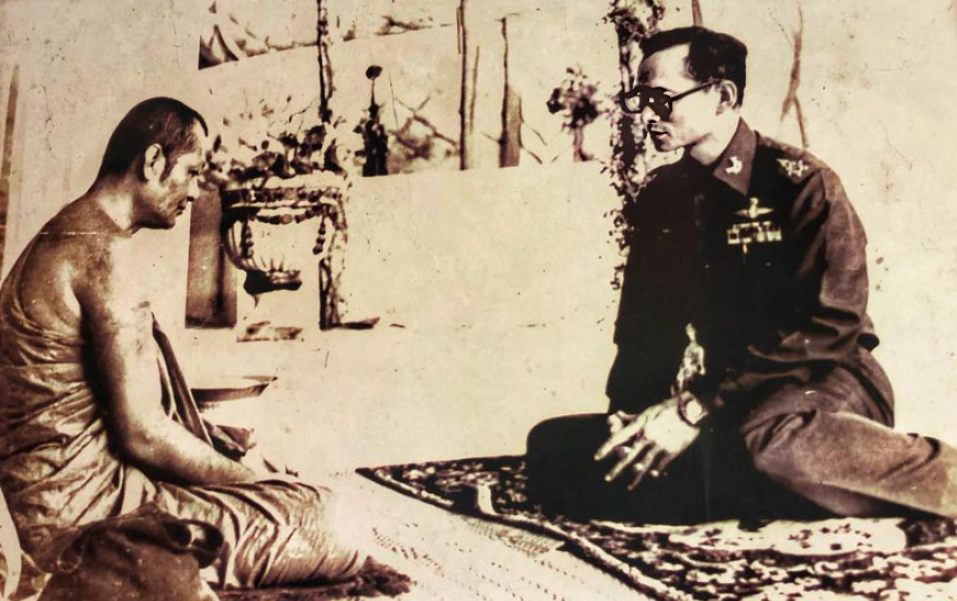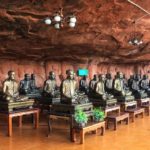King Bhumibol Adulyadej Memorial Day: Royal Projects

HM King Bhumibol Adulyadej The Great Memorial Day (Oct. 13th) honors the life and achievements of King Rama IX, who was the longest-reigning monarch in Thai history. He reigned from 1946 until his passing in 2016. Throughout his reign, King Bhumibol implemented many Royal projects aimed at improving the lives of all Thai people, from the hill tribes of the North and the Isaan people of the Northeast to the Muslims in the deep South (and everywhere in between).
During his life King Bhumibol was not an aloof king, spending his days in opulence. Instead, he was deeply engaged with rural Thai people, on the ground, personally inspecting the progress and impact of his projects and initiatives. This is why he became so beloved by all Thai people, and his death on Oct. 13th 2016 was met with a full year of public mourning.
King Bhumibol Adulyadej Memorial Day is known officially in Thailand as “Navamindra Maharaj Day,” or in Thai: Wan Nawamintha Maharat (วันนวมินทรมหาราช). The words “Navamindra Maharaj” identify HM King Bhumibol as the ninth great king of the Chakri Dynasty, which began with King Rama I in 1782.
In 2006, UN secretary-general Kofi Annan awarded King Bhumibol Adulyadej with the United Nation’s first Human Development Lifetime Achievement Award in recognition of his many Royal projects and his “sufficiency economy” philosophy that drove his work.
It is nearly impossible to summarize all of the Royal projects and initiates that King Bhumibol the Great was involved in during his 70 year reign, but the following list of projects provides a good overview of what was important to His Majesty during his lifetime, and why he is honored every year with a Memorial Day.

Royal Projects of King Bhumibol Adulyadej The Great
The Royal Rainmaking Project (Started in 1955):
The Royal Rainmaking Project, initiated in 1955 by King Bhumibol Adulyadej, was a pioneering effort to enhance water resources in Thailand, especially during periods of drought, through cloud seeding technology. The primary objective was to support agriculture and alleviate water shortages faced by farmers and communities across the country.
By utilizing cloud seeding techniques, the project increased water availability for agricultural purposes. During dry periods and droughts in Thailand, this intervention thus helped to mitigate the impact of water scarcity on crops.
The Royal Rainmaking Project played a vital role in reducing the vulnerability of Thai farmers, ensuring a more stable agricultural output even in adverse weather conditions. By providing a reliable source of water for irrigation, the project bolstered agricultural resilience, safeguarding farmers and communities against the challenges posed by water shortages.
The Royal Project (Started in 1969):
The Royal Project, launched in 1969 King Bhumibol Adulyadej, set out to eradicate opium cultivation in northern Thailand by introducing alternative crops and promoting sustainable agricultural practices. Its primary focus was the hill tribe communities in the region, aiming to improve their living standards while preserving their unique cultural heritage.
Through the cultivation of alternative crops (such as coffee and tea) and the implementation of sustainable agricultural techniques, the Royal Project successfully reduced opium cultivation, providing hill tribe communities with viable economic alternatives.
This shift not only contributed to the decline of the illegal drug trade in Thailand but also empowered these communities economically. By embracing sustainable agriculture, the Royal Project not only improved the livelihoods of Northern Thailand’s hill tribe people but also played a pivotal role in preserving their traditional ways of life, fostering a sense of community and cultural identity.
The Rak Thin Thai Ngam Project (Sustainable Agriculture Project, Started in 1975):
The Rak Thin Thai Ngam Project, launched in 1975 King Bhumibol Adulyadej, was a dedicated effort to promote sustainable agriculture practices throughout Thailand. The project’s core objectives included the implementation of sustainable farming techniques, improvement of soil quality, and enhancement of crop yields. Its target beneficiaries were farmers across the country, aiming to empower them with knowledge and tools for sustainable agricultural development.
Through the introduction of innovative farming methods, the project revolutionized traditional practices, leading to improved soil fertility and enhanced agricultural productivity. Farmers were trained in eco-friendly approaches, crop diversification, and efficient resource management.
Consequently, agricultural yields increased significantly, resulting in higher incomes for farmers. By encouraging sustainable agriculture, the Rak Thin Thai Ngam Project not only elevated the economic status of farmers but also contributed to the overall food security and agricultural sustainability of Thailand.
The Royal Initiative Project on Public Health (Started in 1977):
The Royal Initiative Project on Public Health, launched in 1977 King Bhumibol Adulyadej, was a vital endeavor focused on improving healthcare services and promoting public health awareness in underserved areas of Thailand. The project’s objective was to establish accessible medical facilities, including hospitals, clinics, and healthcare centers, in rural communities where healthcare services were lacking.
The primary beneficiaries were individuals residing in these underserved areas, who previously had limited or no access to medical care. Through strategic planning and investment, the project successfully built essential healthcare infrastructure. Hospitals and clinics were established, providing much-needed medical services to the local population.
Additionally, the project played a pivotal role in raising awareness about preventive healthcare measures, empowering communities with knowledge that led to healthier lifestyles and reduced incidences of diseases.
Pracha Wiwat (Development for the People) Project (Started in 1982):
The Pracha Wiwat Project, initiated in 1982 King Bhumibol Adulyadej, was a concerted effort to promote economic and social development in the southern border provinces of Thailand. The project’s core objective was to enhance the overall quality of life in these regions by improving infrastructure, education, and healthcare facilities. The primary beneficiaries were the communities residing in the southern border provinces, where stability, peace, and socio-economic progress were sought.
Through targeted interventions, the project significantly improved access to education, healthcare, and essential infrastructure. By establishing schools and healthcare centers and enhancing transportation networks, the project fostered economic development and stability in the southern region.
The provision of better educational opportunities and healthcare services not only enhanced the well-being of the local population but also created a foundation for sustainable economic growth and social progress in the southern border provinces of Thailand.

The Chaipattana Foundation (Founded in 1988):
The Chaipattana Foundation, established in 1988 King Bhumibol Adulyadej, aimed to catalyze development across various sectors including agriculture, water resources, environment, healthcare, and rural areas in Thailand. Its primary objective was to uplift the lives of rural Thai communities, farmers, and people throughout the nation.
By promoting innovative agricultural practices, the foundation played a significant role in improving crop yields and agricultural sustainability. Access to clean water was facilitated, addressing a fundamental need in many rural areas in Thailand.
Additionally, the foundation’s initiatives in healthcare enhanced medical services, promoting better health outcomes in underserved regions. Through these multifaceted efforts, the Chaipattana Foundation made substantial contributions to sustainable development, particularly in rural communities, creating a positive impact on the lives of the Thai people it served.
The Pak Mun Dam Development Project (Started in 1991):
The Pak Mun Dam Development Project, initiated in 1991 King Bhumibol Adulyadej, had a crucial objective: to address the environmental impact of the Pak Mun Dam on the local communities and fisheries in Northeast Thailand. The primary beneficiaries were the Isaan communities residing near the dam, whose lives were directly affected.
To mitigate the adverse consequences, the project introduced fish-friendly turbines, a vital measure that facilitated the natural movement of aquatic life, preserving the local fishery ecosystem. Additionally, community-based fisheries were supported, empowering the local Isaan residents to engage in sustainable fishing practices.
By adopting these strategies, the project successfully lessened the negative environmental impact of the dam. As a result, the livelihoods of the local Thai communities were improved, ensuring a more sustainable coexistence with their environment.
The Royal Initiative Project on Environmental Conservation (Started in 1992):
The Royal Initiative Project on Environmental Conservation, initiated in 1992 King Bhumibol Adulyadej, was a proactive effort aimed at promoting environmental conservation and raising awareness about ecological issues in Thailand. The project’s central objective was to support conservation efforts in Thai national parks and wildlife sanctuaries, preserving natural habitats and protecting endangered species.
The project’s beneficiaries included environmentalists, wildlife conservationists, and communities living near protected areas. Through its initiatives, the project contributed significantly to the preservation of natural ecosystems in Thailand. By safeguarding national parks and wildlife sanctuaries, the project protected endangered species and ensured the longevity of diverse flora and fauna.
Moreover, the project played a crucial role in raising environmental consciousness among the public. By educating Thai communities about the importance of ecological balance and biodiversity, the project fostered a sense of environmental stewardship in Thailand. The impact of the Royal Initiative Project on Environmental Conservation was not only ecological but also cultural, nurturing a sense of responsibility for the natural heritage of Thailand among its citizens.
The Royal Initiative Project on Alternative Energy (Started in 1995):
The Royal Initiative Project on Alternative Energy, initiated in 1995 King Bhumibol Adulyadej, was a forward-looking endeavor designed to reduce Thailand’s dependence on fossil fuels by promoting the research, development, and utilization of alternative and renewable energy sources. The project’s primary aim was to benefit energy consumers, environmentalists, and communities affected by energy-related issues.
By encouraging the use of solar, wind, and other renewable energy sources, the project significantly reduced the environmental impact associated with conventional energy production. Through research and development efforts, the project facilitated the integration of renewable energy technologies into the national energy grid, promoting sustainable energy practices.
The project’s impact was twofold: it reduced the carbon footprint, mitigating environmental degradation, and created a foundation for a more sustainable energy future in Thailand. By championing clean and renewable energy, the Royal Initiative Project on Alternative Energy paved the way for a greener and more environmentally conscious energy landscape in the country.
The New Theory Agriculture (Sufficiency Economy) Project (Started in 1997):
The New Theory Agriculture Project, launched in 1997 King Bhumibol Adulyadej, aimed to promote the Sufficiency Economy Philosophy, emphasizing self-reliance, moderation, and balanced development, particularly in the agricultural sector. The project targeted farmers and communities across Thailand, aiming to instill the principles of sustainable living and responsible resource management.
By embracing the Sufficiency Economy Philosophy, farmers were encouraged to adopt practices that reduced dependency on external resources and emphasized prudent use of available resources in Thailand. This approach not only enhanced agricultural productivity but also fostered resilience against economic fluctuations.
Through training and education, Thai farmers gained valuable insights into efficient agricultural methods, crop diversification, and soil conservation. By integrating these principles into their farming practices, communities became more self-sufficient, less vulnerable to external economic shocks, and better equipped to withstand challenges, thus promoting a more sustainable and secure future for farmers across Thailand.
King Bhumibol Adulyadej: Patron of the Arts in Thailand
Lastly, it should be noted that HM King Bhumibol was a generous patron of the arts in Thailand. He initiated several projects that supported and promoted various forms of artistic expression in the country. One notable initiative was the establishment of the Support Foundation under the Royal Patronage of Her Majesty Queen Sirikit of Thailand.
The Support Foundation focused on preserving and promoting traditional Thai arts and crafts. It provided training and support to Thai artisans, helping them preserve their crafts and pass their skills to the younger generation. This initiative played a significant role in maintaining the rich cultural heritage of Thailand.
Additionally, King Bhumibol was an accomplished musician and composer himself. He played various musical instruments and composed numerous songs and musical pieces. His passion for music and the arts influenced cultural activities in Thailand. He often organized musical events and supported the development of Thai classical music and dance, ensuring their preservation and continued practice.
HM King Bhumibol Adulyadej The Great Memorial Day Celebrated?
King Bhumibol Adulyadej Memorial Day (Navamindra Maharaj Day) is most commonly celebrated by a trip to the temple, where worshipers make merit in the name of the late, great King, and offer prayers to him. Provincial halls throughout Thailand will often also hold special events, where photographs of the HM King Bhumibol are displayed, music performed by the King is played, and his many projects are honored.
- The 1st English Dhamma Talk Project, Sakon Nakhon Thailand - July 8, 2025
- Affirmations in Buddhism & Thailand - June 7, 2025
- Speak Thai Naturally Without the Gymnastics - April 20, 2025




